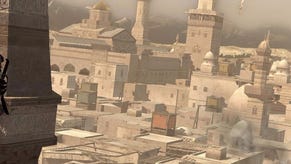Face-Off: Assassin's Creed: Brotherhood
No more tiny Templar.
| Xbox 360 | PlayStation 3 | |
|---|---|---|
| Disc Size | 6.5GB | 7.48GB |
| Install | 6.5GB (optional) | 4169MB (mandatory) |
| Surround Support | Dolby Digital | Dolby Digital, 5.1LPCM |
It's a 10! Assassin's Creed: Brotherhood expertly refines and improves ACII's winning formula, adds in a highly enjoyable online multiplayer mode and sets the stage nicely for the next (final?) instalment in the saga of Desmond Miles.
However, the question remains: if you have access to both an Xbox 360 and PlayStation 3, which version of the game is the one to buy? Historically, the series' tech has favoured the Microsoft console, but the gap narrowed significantly with the advent of ACII, and right from the very beginning of Brotherhood, it's clear that Ubisoft Montreal has made a number of further refinements to the Anvil engine.
So let's beat about the bush no longer and get to work. As per the norm, there are two sets of comparison assets for you to pore over - an exhaustive 720p comparison gallery along with this edited highlights selection of clips from the game.
The Assassin's Creed games have never had a problem in maintaining cross-platform conformity in terms of the core art and the graphical features of the engine, and nothing has changed with Brotherhood. Once again, the only real difference concerns anti-aliasing: just like the previous games, the PS3 version uses the quincunx AA technique where edge-smoothing comes at the expense of blurring textures. Xbox 360 retains the 2x multi-sampling AA common to both of the previous Assassin's Creed titles.
We also see a difference in terms of the gamma level, which used to be a regular occurrence in the Face-Off comparisons but isn't so much of an issue these days. There is some evidence that suggests that this may actually be a hardware issue within the 360. One very prominent developer talked to us recently about how component and HDMI colour levels from the Microsoft console don't seem to match. This is something we plan to investigate in the near-future by dumping the 360's video RAM directly and comparing to a lossless stream from the HDMI port. Hardly a big deal but the findings could be useful in calibrating your display.
Quincunx and gamma aside, the two games are effectively a match, but this is nothing new, as the differentiating factor with the AC titles has always been the performance. In the original Assassin's Creed, performance wasn't spectacular on 360 but was positively woeful on PS3. The sequel showed little to no improvement on the Microsoft platform, but a lot of work had clearly been carried out on the PS3 engine – 360 still commanded the overall advantage, but in several places the Sony console outperformed it.
Similar to the ACII Face-Off, two sets of performance analyses should help us get a good feel for how things stand in Brotherhood. All of the cut-scenes are generated by the engine, and the range of scenes on offer gives us a wealth of effectively identical snippets of action we can analyse and compare on both platforms.
Similar to ACII, in like-for-like scenes we see an overall trend favouring the Xbox 360 version with slightly higher frame-rates on average and lower levels of tearing, with both versions capped at 30FPS in line with Brotherhood's predecessor. The PS3 game appears to have a specific weakness in rendering environments with lots of draw distance - here we see dropped frames a-plenty and lots of tearing whereas 360 is more solid.
However, Ezio's mad dash on horseback through his besieged town throws up some interesting points where the PS3 version is clearly outperforming the Xbox 360 game, so perhaps other game modules (physics, for example) are optimised in favour of the Sony console?
The second set of performance tests come from in-game. Here we are taking on the same series of missions on both platforms. While the renderer obviously isn't processing the exact same scenes, across the whole series of clips we should be able to draw some conclusions on how smoothly the game actually runs when it comes to the crucial matter of gameplay. The missions chosen are designed to cover off long view distances, rooftop traversal and combat.
It's fair to say that in these missions at least, there isn't so much to tell the games apart. We do see the same PS3 weakness on rendering long distance scenes in the initial siege scene but as the other missions don't tend to concentrate on draw distance we see a much closer range of performance. What is clearly evident is that rendering budgets are really pushed beyond their boundaries on both systems when crowd scenes are in evidence.









